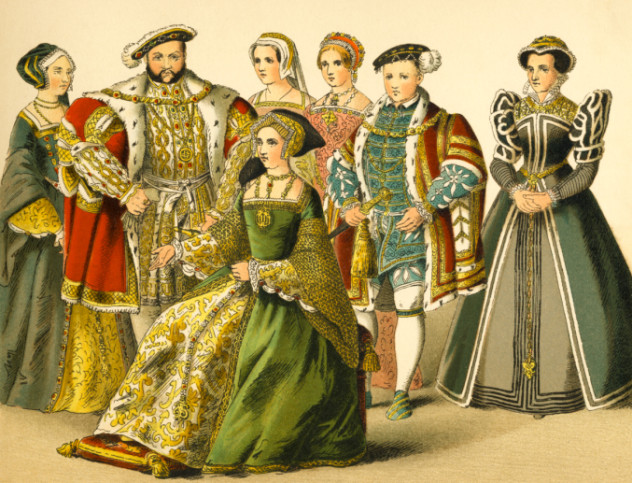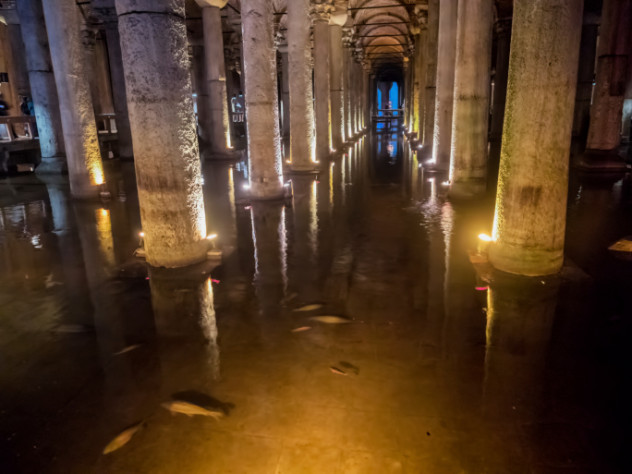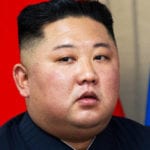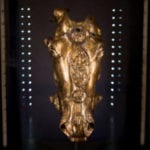 Weird Stuff
Weird Stuff  Weird Stuff
Weird Stuff  Miscellaneous
Miscellaneous Top 10 Things Crypto Was Supposed to Change & What Actually Did
 History
History 10 Huge Historical Events That Happened on Christmas Eve
 Music
Music 10 Surprising Origin Stories of Your Favorite Holiday Songs
 History
History 10 Less Than Jolly Events That Occurred on December 25
 Weird Stuff
Weird Stuff 10 Funny Ways That Researchers Overthink Christmas
 Politics
Politics 10 Political Scandals That Sent Crowds Into the Streets
 Weird Stuff
Weird Stuff Ten Bizarre Facts About The Doge Meme
 Our World
Our World 10 Ways Your Christmas Tree Is More Lit Than You Think
 Movies and TV
Movies and TV The 10 Coolest Stars to Set Sail on The Love Boat
 Weird Stuff
Weird Stuff 10 Fascinating Facts You Might Not Know About Snow
 Miscellaneous
Miscellaneous Top 10 Things Crypto Was Supposed to Change & What Actually Did
 History
History 10 Huge Historical Events That Happened on Christmas Eve
Who's Behind Listverse?

Jamie Frater
Head Editor
Jamie founded Listverse due to an insatiable desire to share fascinating, obscure, and bizarre facts. He has been a guest speaker on numerous national radio and television stations and is a five time published author.
More About Us Music
Music 10 Surprising Origin Stories of Your Favorite Holiday Songs
 History
History 10 Less Than Jolly Events That Occurred on December 25
 Weird Stuff
Weird Stuff 10 Funny Ways That Researchers Overthink Christmas
 Politics
Politics 10 Political Scandals That Sent Crowds Into the Streets
 Weird Stuff
Weird Stuff Ten Bizarre Facts About The Doge Meme
 Our World
Our World 10 Ways Your Christmas Tree Is More Lit Than You Think
 Movies and TV
Movies and TV The 10 Coolest Stars to Set Sail on The Love Boat
10 Surprising Phobias Of ‘Fearless’ Historical Leaders
Fear is a basic human emotion we all experience, and the great leaders of the past were no exception. These historical figures had strange and specific fears in their lifetimes that often conflict with the air of fearlessness with which they’re portrayed in history books.
10 Franklin D. Roosevelt
Fire

Though he said that “the only thing we have to fear is fear itself,” Franklin D. Roosevelt had an intense personal fear of fire. His fear was likely to stem from his childhood, when he had several frightening experiences. As a young child, he witnessed his young, screaming aunt Laura running down the stairs with her dress ablaze from a spilled alcohol lamp.
In 1899, he helped to tear up part of a parlor floor to put out a cellar blaze and participated in a bucket brigade to put out a stable fire at the nearby Groton School. Speaking of the incident later to his parents, he described the “horrible scene [. . .] the poor horses lying under the debris with their hide entirely burned off and fearfully charred [because] there was no back door.”
His phobia increased after he lost the use of his legs in the 1920s; he feared being immobilized in a burning building, unable to escape. During his presidency, his fear of fire even outweighed his fear of assassination. He refused to lock the door to the presidential bedroom at night in case of fire, forcing the Secret Service to maintain regular patrols in the hallway each night.
His wife is said to have commissioned an architect to design a special fire escape chute for him to use. It is unknown if it was ever built, but the plans are filed with the Secret Service Archives in the FDR Library. Despite his fear, Roosevelt still insisted his family Christmas tree be decorated with candles rather than electric lights.
9 Genghis Khan
Dogs

According to legend and some passages of the biographical Secret History of the Mongols, Genghis Khan feared only three things: his mother, his wife, and dogs. When Genghis Khan was still an eight-year-old boy named Temujin, his father Yesugei met a man on the steppe named Dei-Tsetsen. Dei-Tsetsen had a daughter named Borte who was a year older than the future Khan. The two fathers agreed to a marriage between their children. Yesugei left his son with his future in-laws to work off the cost of the future dowry, warning them that “my son is afraid of dogs. My kinsman, don’t let my boy be frightened by dogs!”
Some have criticized Genghis Khan for his cowardice around dogs, but the fear was probably a wise precaution. Mongolian dogs were bred to be large and vicious, notorious for attacking and ripping apart unwary travelers. The Mongols referred to them as “big and bony brutes, long-haired and shaggy, loud-voiced and vicious, they are to be feared and avoided” and added that “they will jump at you even if you are on a horse or camel, and they are sometimes too much to handle if you are on foot.”
8 Kim Jong Il
Flying

Former North Korean dictator Kim Jong Il was known for a morbid fear of flying, almost always choosing to travel by armored train—even during long visits to the Soviet Union and Eastern Europe. His father, Kim Il Sung, once flew regularly on trips to the Soviet Union, but both father and son developed a severe distrust for air travel due to a number of incidents.
According to Ingolf Kiesow, former Swedish ambassador to North Korea, Kim Jong Il had a scar running from his forehead to the top of his head, visible when meeting in person. This was allegedly from a 1976 helicopter crash that caused serious physical injury, psychological trauma, and flashbacks later in life.
In 1982, North Korea purchased five IL-62 passenger planes from the Soviet Union to use as Kim Il Sung’s exclusive aircraft. While watching a test flight, Kim Il Sung saw the plane suddenly explode in midair and kill 17 people, including his personal pilot. It is said that neither of the Kims would consent to riding in an aircraft with a North Korean pilot after that, largely sticking to the rails, though Kim Il Sung was willing to fly with a Russian pilot to visit Gorbachev in 1986.
The new leader, Kim Jong Un, doesn’t appear to share the fears of his father or grandfather, frequently pictured disembarking planes and even riding in the cockpit.
7 Henry VIII
Disease

One of the most notorious Tudors, King Henry VIII had an intense fear of disease, specifically of the plague and the mysterious sweating sickness plaguing England during his reign. The Tudors had a tradition of “progresses” during which the king and his entourage would tour the countryside to visit noble estates and monasteries to win the affection of their subjects. The tradition was waning due to the rise of fixed palaces and courts, but Henry VIII still performed them each summer. During the plague years, he tried to isolate himself as much as possible from the potentially diseased while still making progresses, somewhat nullifying their impact on winning the hearts and minds of the populace.
During a sweating sickness outbreak in London in 1528, Henry VIII fled the capital with the queen and his mistress Anne Boleyn, sleeping in a different house each night until he could finally hole up in the Hertfordshire residence of the Abbot of Saint Albans, far from the contagion. When one of Anne Boleyn’s handmaidens contracted the disease, Henry fled to an unidentified house almost 20 kilometers (12 mi) away. He ordered Anne back to her father’s house, though he did send the second-best physician in the country to care for her.
When Cardinal Wolsey suggested the plague might be the punishment of an angry God for the King’s desire to have his marriage nullified, Henry burst into a rage. According to the French ambassador, “the King used terrible words, saying he would have given a thousand Wolseys for one Anne Boleyn.” Fortunately for Wolsey and his kin, Anne recovered. The plague died out in London, allowing the royal household to return, though we can’t exactly say they lived happily every after.
6 Augustus Caesar
Lightning

According to Roman historian Suetonius, the founder of the Roman Empire was afraid of thunder and lightning. While sitting in a litter at night during the Cantabrian campaign, Augustus Caesar narrowly escaped a bolt of lightning that struck nearby, scorching the litter and killing a slave who was walking ahead with a torch. A fearful and superstitious Augustus quickly had the Temple of Jupiter the Thunderer built to appease the god, but his fear remained with him throughout his life.
Suetonius claims Augustus always carried a piece of seal skin as an amulet for protection. When threatening storms approached, he would take refuge in an underground vault. He probably had a supply of candles down there, too, as some say Augustus also had a fear of sitting alone in the dark. Suetonius it isn’t clear whether Augustus Caesar had another true phobia or just a propensity for insomnia and boredom while lying awake at night.
5 Heraclius
Water

Byzantine emperor Heraclius had a period of great victories against the Persians, but reversals and defeats at the hands of the expanding Muslim armies caused him to develop a number of nervous conditions, including a fear of water. While retreating with his army following a crushing defeat by the Arabs in Syria, he delayed a crucial tactical retreat out of Asia Minor across the Bosphorus. After several weeks of lingering in his palace at Hiereia, he was finally induced to cross over a bridge of boats lined with tree branches.
He is even said to have had a number of cisterns in Constantinople filled in with soil due to his fear, and modern Turkish archaeologists have discovered such cisterns filled with debris. Some, however, seem to have been cleared out by the less fearful Emperor Basil I. The emperor’s fear has been linked to a horoscope cast by the influential astrologer Stephanos of Alexandria, who predicted Heraclius would die by drowning.
4 Peter The Great
Insects And High Ceilings

The progressive Russian tsar Peter the Great was said to have a particular dislike for cockroaches—he would flee an apartment or building if he encountered one. When touring the countryside, he would make sure houses he was about to enter were swept by his servants to ensure that they were cockroach-free.
Once, on a visit to the wooden country house of an officer, the tsar was just sitting down to dinner when he asked his host whether the house had cockroaches. “Not many,” the officer replied. “And the better to get rid of them, I have pinned a living one to the wall.” According to the anecdote, the tsar turned to see the writhing insect pinned to the wall right next to his head. He rose, punched the officer in the face, and left with all his attendants.
Peter the Great was also said to have a mild fear of open spaces, disliking wide rooms and high ceilings. He avoided large palaces while abroad. When staying in a room with a high ceiling, he would ask for a canvas to be hung low, creating a more cramped and cozy environment.
3 Muammar Gadhafi
Heights And Long Flights

Former Libyan dictator Muammar Gadhafi was by all accounts a difficult man to work for, made worse by eccentric phobias of heights and long flights over open water.
According to a cache of secret diplomatic cables released through Wikileaks, the dictator could not fly over open water for more than eight hours, causing logistical headaches for his staff. They organized alternative routes and frequent layovers to calm his nerves, stopping in Portugal during a trip to the United States and planning a layover in Newfoundland when returning to Libya from a trip to Venezuela.
It is even said to have influenced his choice of accommodation. United States Ambassador to Libya Gene A. Cretz claimed the leader could not climb more than 35 steps and had to stay on the first floor of any building rented for him. His dislike for staying in the upper floors of hotels drove him to prefer a New Jersey mansion strangely dubbed “Thunder Rock,” or opt to simply pitch his Bedouin tent, which showed off his traditionalist street cred.
2 Winston Churchill
Public Speaking
Though now known as one of the greatest speakers of the 20th century, former British Prime Minister Winston Churchill once struggled with a stutter that made his early attempts at public speaking nerve-racking experiences. As a newly elected representative at the age of 29, he stood up to give a speech to the House of Commons and froze in terror for three minutes before returning to his seat and covering his face with his hands. He resolved to never suffer such indignity again.
He compensated for his stutter by preparing public remarks weeks in advance—with the added benefit of becoming more knowledgeable and well-versed in key issues than other politicians. He would even practice nonsense phrases as he walked to help overcome his speech impediment, like “The Spanish ships I cannot see since they are not in sight.”
Some argue it wasn’t a stutter at all, but rather a lisp that Churchill struggled to overcome. Regardless, through great perseverance, he was able to overcome his earlier fears and become one of the greatest public speakers of all time, later stating, “My impediment is no hindrance.”
1 Adolf Hitler
Dentists

Hitler had a phobia of visiting the dentist, which is almost distressingly humanizing. In 2009, Menevse Deprem-Hennen released a book called Dentist of the Devil that detailed the career of Brigadefuhrer Dr. Hugo Blaschke, Deputy Chief Dental Surgeon of the SS, who worked as Hitler’s dentist for nearly 20 years. Deprem-Hennen found the documents that had been spirited out by Jewish dentist Fedor Bruck, who was hiding in Berlin during the war, before they could be confiscated by Soviets who were very interested in verifying Hitler’s dental record.
Hitler allegedly suffered from a range of oral health problems due to his fear of the dentist—as well as a sweet tooth. Blaschke noted Hitler frequently complained of pain and had “terrible bad breath, yellowing teeth, abscesses and gum disease.” He once insisted that a simple root canal be spread over eight days, claiming to be unable to handle the pain. Some have suggested Hitler’s poor oral health may have contributed to his psychological anxieties and overall decline in health toward the end of the war.
Hitler was known to be squeamish about teeth, once complaining to Benito Mussolini about a trying meeting with Spanish dictator General Franco: “I would rather have two or three teeth out than go through that again!” Another prominent Nazi who was afraid of the dentist was Luftwaffe head Hermann Goring, who had to be given prosthetic teeth and, according to Blaschke, “cried before he even got in the chair.”
David Tormsen has an irrational fear of historical leaders hiding behind the bathroom door. Email him at [email protected].








